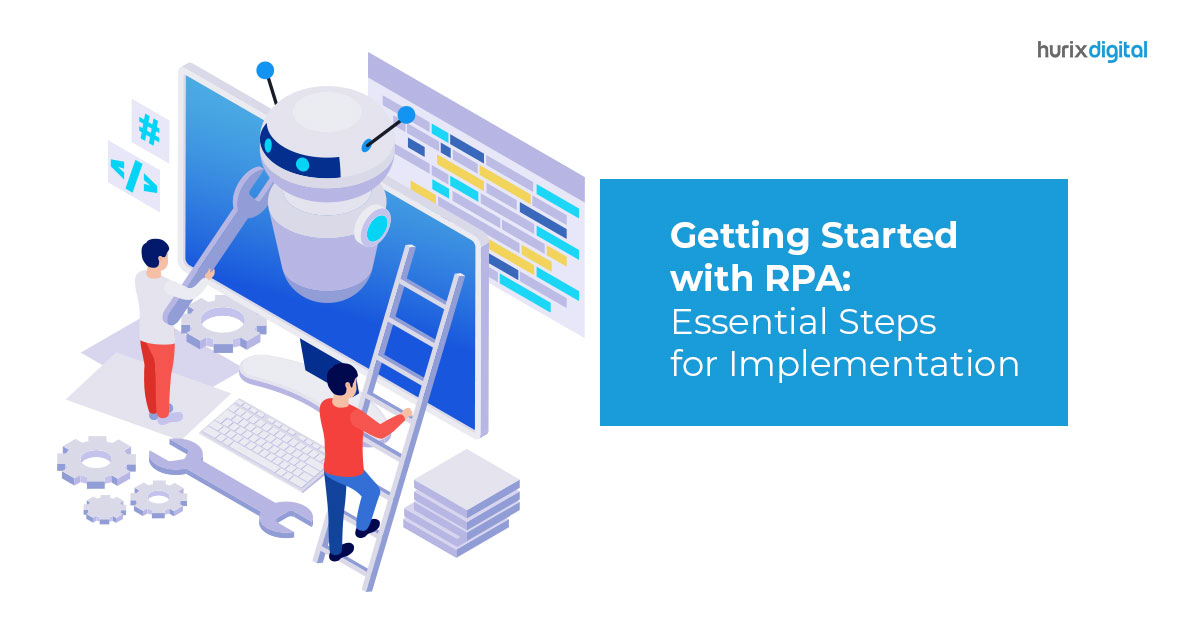Getting Started with RPA: Essential Steps for Implementation
Companies today are rapidly adopting robotic process automation (RPA) as a part of their digital transformation strategy. A 2023 survey by Intelligent Automation Network finds that 42% of digital transformation leaders currently leverage RPA, and 54% plan to invest in RPA in 2023.
There is no doubt that RPA is a powerful technology to increase efficiency and save costs, and businesses are excited about its tremendous potential. But that doesn’t mean you dive headfirst into the technology. Many RPA implementations fail because organizations underestimate the need to strategize.
To help you employ robotic process automation tools, we’ve outlined the essential steps to take when embarking on an RPA project. These best practices will help you confidently navigate RPA implementation.
Table of Contents
- Identifying Process Suited for RPA
- Integrating RPA with Existing System
- Data Management Challenges
- Security Issues
- Scalability Concerns
- Identify and Prioritize Processes
- Involve Stakeholders
- Select the Right RPA Tool
- Conduct a Proof of Concept (POC)
- Design Process Workflows
- Develop and Test RPA Bots
- Implement Change Management
- Deploy and Monitor
- Scale Up
Challenges with RPA Implementation
RPA indeed offers several benefits to organizations across dimensions. As per Deloitte’s Global Robotics Survey, it has improved productivity for 95% of its users, compliance for 93%, and reduced costs for 81%.
However, implementing RPA for business process automation is not without its challenges. Identifying these challenges will prepare organizations and enable them to create strategies to overcome them.
Also Read: How RPA is Transforming Business Processes: Benefits and Use Cases
Here are the common challenges associated with RPA deployment:
1. Identifying Process Suited for RPA
Not all tasks are suitable for RPA. Ideally, the RPA process is well suited for rule-based and repetitive tasks that require working with large data volumes. Identifying which processes to automate and which not to can be tricky.
2. Integrating RPA with Existing System
RPA programs do not work in isolation but must interact with various software applications. Sometimes, these systems may not be compatible with the automation software. You may have to put in extra effort to make everything run smoothly.
3. Data Management Challenges
Automation tools rely heavily on accurate and reliable data to perform tasks. If the data is incomplete or inconsistent, it can lead to errors in the automated processes. Hence, maintaining data quality and integrity becomes crucial for successful RPA implementation.
4. Security Issues
RPA involves robots handling sensitive data and performing tasks on behalf of humans. Ensuring the security of the data they handle is of utmost importance. Adequate security measures must be implemented to prevent unauthorized access and data breaches.
5. Scalability Concerns
Despite leaders supporting RPA implementation, organizations struggle to scale RPA as anticipated. The main barriers include fragmented processes (32%), lack of clear vision (17%), and lack of IT readiness (17%). Organizations must carefully plan RPA scaling across multiple processes and departments.
Also Read: RPA Vs. Traditional Automation: Understanding the Key Differences
What are the Critical Steps for Successful RPA Implementation?
Implementing Robotic Process Automation requires careful planning. Common automation mistakes can hamper its successful execution. To avoid failure, do not miss out on these critical RPA implementation steps:
1. Identify and Prioritize Processes
Start by identifying which tasks are best suited for automation. As mentioned above, look for repetitive, consistent, and rule-based processes. Some examples of such tasks are data entry, invoice processing, reconciliation, report generation, client onboarding, KYC, etc.
These tasks are less complex to automate and will ensure a smoother implementation. Also, prioritize RPA implementation on processes that will significantly improve efficiency and cost-saving from automation.
2. Involve Stakeholders
When implementing any new technology, it’s crucial to involve key people from the organization affected by it. For RPA, it could be process owners, IT teams, and employees.
Listen to their input and insights, and address their concerns. The adoption of RPA will become more effective with their support and cooperation.
3. Select the Right RPA Tool
When it comes to robotic process automation tools, there is no one-size-fits-all. Each business has to conduct its research and choose an RPA tool that meets its needs. The most important factors you should consider when selecting automation platforms are:
- Functionality and Features
- Ease of Use
- Compatibility with Existing Systems
- Customization and Scalability
- Security and Data Protection
- Vendor support and reputation
- Cost and Pricing Model
Evaluate different options with the help of your IT teams. Most vendors offer free trial options, so take advantage of them.
4. Conduct a Proof of Concept (POC)
It’s always prudent to conduct a feasibility assessment of the RPA program first through a small-scale proof of concept. Select a representative process and run the automation to evaluate its effectiveness.
Did the process benefit your team? Gather their feedback, address their challenges, and make adjustments. Your team must have confidence in the chosen RPA tool before you decide to scale the process across the organization.
5. Design Process Workflows
While developing RPA, you must include all necessary steps in the process. Map out the step-by-step workflows for the processes to be automated. Document the inputs, outputs, decision points, and actions the RPA tools will perform.
This detailed design will act as a blueprint for the development team and provide them with clarity during implementation.
6. Develop and Test RPA Bots
Once you have designed the RPA process workflows, it’s time to bring them to life by developing the RPA bots. These bots will interact with the required software applications and manage data.
But before they go live, thorough testing is crucial. Test the bots in various scenarios to ensure they can also handle exceptions if they arise.
7. Implement Change Management
It’s normal for staff to resist IT process automation. The key to overcoming the resistance is communication. Communicate the purpose and benefits of RPA to your employees and address any concerns they may have.
Provide training to help them adapt to the new automated processes. Emphasize how RPA enhances their work instead of replacing it. Clear communication and ongoing support will make the transition smoother for everyone.
8. Deploy and Monitor
Once your RPA bots have passed the testing phase, it’s time to deploy them into the production environment. But your job doesn’t end with deployment. It’s crucial to monitor their performance.
Review key metrics to ensure RPA programs operate efficiently and deliver the expected results. Proactive monitoring allows you to identify issues and address them promptly.
9. Scale Up
After successfully automating the initial processes, it’s time to think bigger. Identify additional tasks or processes that can benefit from RPA and expand the automation across different departments or functions.
First, create a roadmap for scaling up your RPA implementation. Evaluate new opportunities and gradually expand automation to unlock the full potential of RPA across your organization.
Enable RPA and Enhance Business Outcomes with Hurix
At HurixDigital, we specialize in automating business processes to improve efficiency and accuracy. Our dedicated team of professionals focuses on research, innovation, and strategic recommendations to maximize your ROI.
We provide cost-effective and scalable RPA solutions that drive enterprise-wide transformation. We go beyond conventional automation by integrating machine learning and artificial intelligence, enabling a true digital transformation for your business.
From strategy to implementation and continuous improvement, we provide comprehensive RPA services that ensure error-free output and drive business value.
Contact us today to harness the power of RPA and unlock the full potential of your business.

SVP & Head – Hurix Technology Solutions
Global Delivery head with 25 years of working experience in NYC investment banks and fintech companies. Hands-on technology delivery management and program management, accountable for stakeholder relationships, Strategic roadmap, P&L, Revenue growth, Account Management, and employee satisfaction.









